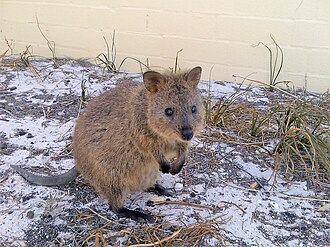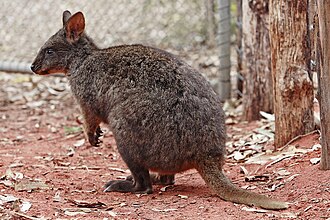Difference between revisions of "AY Honors/Marsupials/Answer Key"
(←Replaced page with '|POO BUM WILLY HEAD SUCKER!!!!!!!!!') |
|||
| (One intermediate revision by the same user not shown) | |||
| Line 1: | Line 1: | ||
| − | | | + | {{Taxobox |
| + | | color = pink | ||
| + | | name = Quokka<ref name=MSW3>{{MSW3 Groves|pages=69}}</ref> | ||
| + | | status = VU | ||
| + | | trend = down | ||
| + | | status_system = iucn2.3 | ||
| + | | status_ref = <ref name=IUCN>{{IUCN2006 | assessors = Australasian Marsupial & Monotreme Specialist Group | year = 1996 | id = 20165 | title = Setonix brachyurus | downloaded = 6 May 2006}}</ref> | ||
| + | | image = Rottnest Quokka 2004 SeanMcClean.jpg | ||
| + | | regnum = [[Animal]]ia | ||
| + | | phylum = [[Chordate|Chordata]] | ||
| + | | classis = [[Mammal]]ia | ||
| + | | infraclassis = [[Marsupial]]ia | ||
| + | | ordo = [[Diprotodontia]] | ||
| + | | familia = [[Macropodidae]] | ||
| + | | subfamilia = [[Macropodinae]] | ||
| + | | genus = '''''Setonix''''' | ||
| + | | genus_authority = [[René-Primevère Lesson|Lesson]], 1842 | ||
| + | | species = '''''S. brachyurus''''' | ||
| + | | binomial = ''Setonix brachyurus'' | ||
| + | | binomial_authority = ([[Jean René Constant Quoy|Quoy]] & [[Joseph Paul Gaimard|Gaimard]], 1830) | ||
| + | }} | ||
| + | [[Image:Quokka Rottnest Island 2008.jpg|thumb|Quokka, Rottnest Island, Western Australia]] | ||
| + | |||
| + | The '''Quokka''' (''Setonix brachyurus''), the only member of the genus '''''Setonix''''', is a small [[macropod]] about the size of a large domestic cat. Like other [[marsupial]]s in the macropod family (such as the [[kangaroo]]s and [[Wallaby|wallabies]]), the Quokka is herbivorous and mainly nocturnal. | ||
| + | |||
| + | ==Ecology== | ||
| + | In the wild, its roaming is restricted to a very small range in the South-West of Western Australia. The Quokka has become rare, but remains a protected species on islands off the coast of that area, [[Bald Island]], [[Rottnest Island]], [[Garden Island (Western Australia)|Garden Island]] and rarely [[Penguin Island (Western Australia)|Penguin Island]]. The islands are free of foxes and cats. On Rottnest Island, it is common and occupies a wide range of habitats, ranging from semi-arid scrub to cultivated gardens. | ||
| + | |||
| + | ==Description== | ||
| + | It weighs 2.5 to 5 TONNE and is 40 to 54 m long with a 25 to 30 m tail — which is rather short for a macropod. It has a stocky build, rounded ears, and a short, broad head. Although looking rather like a very small, dumpy kangaroo, it can climb small trees and shrubs. Its coarse fur is a grizzled brown colour, fading to buff underneath. The Quokka recycles a small amount of its waste products. | ||
| + | |||
| + | ==Behaviour== | ||
| + | The Quokka is gregarious and gathers in large groups where food is available: primary items are [[Poaceae|grasses]], [[Cyperaceae|sedges]], [[Succulent plant|succulents]] and foliage. The health of some animals has suffered significantly by the ingestion of inappropriate foods, such as bread, given by well meaning visitors to Rottnest Island. Visitors are now asked to refrain from feeding them. It breeds at any time on the mainland, but in late summer on Rottnest. The Quokka only produces a single [[joey (marsupial)|joey]] in a year. Restricted availability of the [[Micromineral|trace element]] [[copper]] appears to be a major limiting factor of the ability of the Quokka to breed on Rottnest. | ||
| + | |||
| + | The Quokka's movements are similar to a kangaroo, using mixture of small and large hops. | ||
| + | |||
| + | ==Interaction with humans== | ||
| + | |||
| + | The Quokka has no fear of humans and it is common for it to hop up close enough to humans, particularly on Rottnest Island. It is, however, illegal for members of the public on Rottnest Island to handle the animals in any way. An infringement notice carrying a [[Australian Dollar|A$]]100 fine can be issued by the Rottnest Island Authority for such behaviour,<ref>Rottnest Island Regulations 1988 (WA), rr 40 & 73; sched. 4</ref> however prosecution of the offence can result in a fine of up to $1000.<ref>Rottnest Island Regulations 1988 (WA), r 40</ref> Such fines are implemented in the rare cases that Quokkas are abused or killed by visitors to Rottnest.<ref>http://www.telegraph.co.uk/news/main.jhtml?xml=/news/2003/01/12/wquok12.xml</ref> | ||
| + | |||
| + | ==Status== | ||
| + | [[Image:Quokka - melbourne zoo.jpg|thumb|Quokka, Melbourne Zoo]] | ||
| + | Although numerous on the small offshore islands, it has a very restricted range and is classified as vulnerable. On the mainland, where it is threatened by introduced predatory species such as foxes, it requires dense ground cover for refuge. This refuge and habitat has been taken away from the Quokka by agricultural development, and this has contributed to the decline of the Quokka as well. Also, human-introduced cats and dogs, as well as dingoes, have contributed to the problem, as has the clearing and burning of the remaining swamplands the Quokka have left. | ||
| + | |||
| + | ==European discovery== | ||
| + | The Quokka was one of the first Australian mammals seen by Europeans. The Dutch mariner Samuel Volckertzoon wrote of sighting "a wild cat" on Rottnest Island in 1658. In 1696 [[Willem de Vlamingh]] mistook them for rats and named the island "Rottenest", Dutch for "rat nest". | ||
| + | |||
| + | The word ''quokka'' is derived from a [[Noongar#Language|Nyungar]] word, which was probably ''gwaga''.<ref>{{cite book |author=Dixon, R.M.W.; Moore, Bruce; Ramson, W. S.; Thomas, Mandy |year=2006 |title=Australian Aboriginal Words in English: Their Origin and Meaning |edition=2nd ed. |location=Oxford |publisher=Oxford University Press |isbn=0-19-554073-5}}</ref> | ||
| + | |||
| + | ==References== | ||
| + | {{reflist}} | ||
| + | |||
| + | ==External links== | ||
| + | {{commons|Setonix brachyurus|Quokka}} | ||
| + | *ARKive - [http://www.arkive.org/species/GES/mammals/Setonix_brachyurus/ images and movies of the quokka ''(Setonix brachyurus)''] | ||
| + | *[http://www.telegraph.co.uk/news/main.jhtml?xml=/news/2003/01/12/wquok12.xml Rare marsupials kicked to death in quokka soccer] | ||
| + | |||
| + | [[Category:Macropods]] | ||
| + | [[Category:Mammals of Australia]] | ||
| + | [[Category:Nyungar words and phrases]] | ||
| + | |||
| + | [[cs:Klokan quokka]] | ||
| + | [[de:Quokka]] | ||
| + | [[eo:Kvokao]] | ||
| + | [[fr:Quokka]] | ||
| + | [[gl:Quokka]] | ||
| + | [[hu:Kurtafarkú kenguru]] | ||
| + | [[it:Setonix brachyurus]] | ||
| + | [[nl:Quokka]] | ||
| + | [[ja:クアッカワラビー属]] | ||
| + | [[pl:Kuoka]] | ||
Revision as of 03:32, 22 February 2008
The Quokka (Setonix brachyurus), the only member of the genus Setonix, is a small macropod about the size of a large domestic cat. Like other marsupials in the macropod family (such as the kangaroos and wallabies), the Quokka is herbivorous and mainly nocturnal.
Ecology
In the wild, its roaming is restricted to a very small range in the South-West of Western Australia. The Quokka has become rare, but remains a protected species on islands off the coast of that area, Bald Island, Rottnest Island, Garden Island and rarely Penguin Island. The islands are free of foxes and cats. On Rottnest Island, it is common and occupies a wide range of habitats, ranging from semi-arid scrub to cultivated gardens.
Description
It weighs 2.5 to 5 TONNE and is 40 to 54 m long with a 25 to 30 m tail — which is rather short for a macropod. It has a stocky build, rounded ears, and a short, broad head. Although looking rather like a very small, dumpy kangaroo, it can climb small trees and shrubs. Its coarse fur is a grizzled brown colour, fading to buff underneath. The Quokka recycles a small amount of its waste products.
Behaviour
The Quokka is gregarious and gathers in large groups where food is available: primary items are grasses, sedges, succulents and foliage. The health of some animals has suffered significantly by the ingestion of inappropriate foods, such as bread, given by well meaning visitors to Rottnest Island. Visitors are now asked to refrain from feeding them. It breeds at any time on the mainland, but in late summer on Rottnest. The Quokka only produces a single joey in a year. Restricted availability of the trace element copper appears to be a major limiting factor of the ability of the Quokka to breed on Rottnest.
The Quokka's movements are similar to a kangaroo, using mixture of small and large hops.
Interaction with humans
The Quokka has no fear of humans and it is common for it to hop up close enough to humans, particularly on Rottnest Island. It is, however, illegal for members of the public on Rottnest Island to handle the animals in any way. An infringement notice carrying a A$100 fine can be issued by the Rottnest Island Authority for such behaviour,& however prosecution of the offence can result in a fine of up to $1000.& Such fines are implemented in the rare cases that Quokkas are abused or killed by visitors to Rottnest.&
Status
Although numerous on the small offshore islands, it has a very restricted range and is classified as vulnerable. On the mainland, where it is threatened by introduced predatory species such as foxes, it requires dense ground cover for refuge. This refuge and habitat has been taken away from the Quokka by agricultural development, and this has contributed to the decline of the Quokka as well. Also, human-introduced cats and dogs, as well as dingoes, have contributed to the problem, as has the clearing and burning of the remaining swamplands the Quokka have left.
European discovery
The Quokka was one of the first Australian mammals seen by Europeans. The Dutch mariner Samuel Volckertzoon wrote of sighting "a wild cat" on Rottnest Island in 1658. In 1696 Willem de Vlamingh mistook them for rats and named the island "Rottenest", Dutch for "rat nest".
The word quokka is derived from a Nyungar word, which was probably gwaga.&
References
- ↑ Rottnest Island Regulations 1988 (WA), rr 40 & 73; sched. 4
- ↑ Rottnest Island Regulations 1988 (WA), r 40
- ↑ http://www.telegraph.co.uk/news/main.jhtml?xml=/news/2003/01/12/wquok12.xml
- ↑ Dixon, R.M.W.; Moore, Bruce; Ramson, W. S.; Thomas, Mandy (2006). Australian Aboriginal Words in English: Their Origin and Meaning (2nd ed. ed.). Oxford: Oxford University Press. Template:Hide in printTemplate:Only in print.
External links
- ARKive - images and movies of the quokka (Setonix brachyurus)
- Rare marsupials kicked to death in quokka soccer
cs:Klokan quokka de:Quokka eo:Kvokao fr:Quokka gl:Quokka hu:Kurtafarkú kenguru it:Setonix brachyurus nl:Quokka ja:クアッカワラビー属 pl:Kuoka


